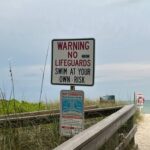INDIAN RIVER COUNTY – Shark fishermen will be allowed to continue baiting and chumming the waters along unguarded beaches. Commissioners Tuesday decided that the issue is a matter for the state to decide.
Commissioner Joe Flescher had asked his fellow commissioners to consider establishing a 300- to 500-foot buffer on both ends of guarded beaches to give lifeguards time to spot potential shark threats.
“I don’t think sharks should be played with,” he said. “They’re not toys.”
The commissioner pointed out that those who compete in onshore shark fishing tournaments pull the sharks up onto the beach, pose with it for photos and sometimes keep it out of the water for too long that the creature becomes distressed when returned to the ocean.
County lifeguard John Frazier told commissioners that he would support the buffer.
“I would like to see something done,” Frazier said.
He said that the lifeguards have been closing the beaches for short periods of time as baitfish school and pass through close to shore. They close the beaches as matter of safety and as a precaution due to the known sharks in the area.
Commissioners, instead, directed County Attorney Alan Polackwich to draft a letter to state officials asking them to address the issue.
Flescher, who brought up concerns from some residents who had witnessed onshore shark fishing tournaments on the barrier island last month, told his fellow commissioners that it would make sense to establish such a buffer area.
Commission Chair Peter O’Bryan disagreed.
“We’ve moved the problem” rather than addressed it by establishing a buffer, he said. He used Wabasso Beach as an example, noting that 300 feet outside the guarded area would put the shark fishermen on the Disney resort beach.
O’Bryan added that he would almost rather have the shark fishing within the guarded area so that lifeguards would be close enough to respond to any emergencies.
Dr. Richard Grant Gilmore Jr., president and senior scientist of Estuarine, Coastal and Ocean Science Inc., made a presentation before the Board of County Commissioners prior to the discussion.
He showed commissioners the jaws of four species of sharks that are known to frequent the waters off Indian River County, including tigers, bulls, black tips and spinners.
Dr. Gilmore said that the majority of bites come from black tips and spinners, which typically bite human hands or feet in a case of mistaken identity. The bites, he said, inflict minor damage.
Tigers and bulls, on the other hand, can cause severe damage. The county’s lone fatal shark attack occurred 12 years ago at Jaycee Beach when a tiger shark attacked a swimmer.
“We do have a potential for concern,” Dr. Gilbert said of baiting sharks along the shore – but how much concern would require study.
“You can’t just say ‘shark,'” he said, explaining that the various shark species pose different threat levels. Also, the type of bait used varies based on the type of shark targeted.
Polackwich told commissioners that they had two options before them – pass a “simplified” and “knee jerk” ordinance prohibiting the onshore shark fishing or craft an ordinance based on scientific data and study.
“I think it starts with science,” the county attorney said.
Dr. Gilbert said that whoever were to study the risk of onshore shark fishing should spend a full year – studying the shark population throughout all the seasons.
“You’ve got to balance rights,” Commissioner Wesley Davis said – rights of the beach bathers and those who wish to fish, regardless of the type of fish.






